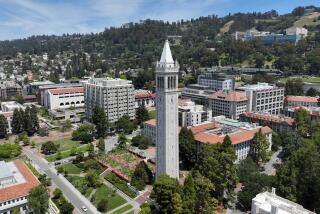Putting the UC System Under the Microscope : Ever-rising fees underscore the need for full public scrutiny
- Share via
The University of California is one of the glories of the Golden State. The status of the university is nonetheless called into question by its decision to raise student fees $605, or 20%. At $3,650 and climbing rapidly, UC fees are now high enough to exclude many qualified students.
The University of California already relies heavily on private funding. In effect, its public subsidy has become a platform from which it raises private funds for the rest of its budget. If current plans are implemented, it may soon undertake for-profit scientific ventures. In what sense is this still a public university?
DEJA VU: The fee-hike ritual, alas, has become all too familiar: budget shortfall, fee-hike announcement, angry student demonstrations, rueful support on editorial pages like this one, implementation of the hike and then sullen quiet until the next round. The only difference is that the intervals between successive rounds are growing shorter. Unless Sacramento is more generous with the university in the next budget cycle, UC officials predict new fee hikes before next fall.
What’s the alternative? In the short run, to be sure, there is no alternative to raising fees. We regret that the UC regents talked UC President Jack Peltason out of imposing a $1,000 surcharge on professional school fees. Those paying the surcharge are years closer to gainful occupation than their undergraduate compatriots are. But talk of which fees should be increased misses the deeper point.
In guiding the university into California’s educational future, university officials have regarded student fees and state funding as, essentially, the only variables. In business management terms, this is the equivalent of addressing a poor economic performance always and only by raising the price. There is, to put it mildly, a long list of topics that university management might consider in addition to fee hikes and increased state funding.
If the university cannot prepare such a list for itself, then the state must do so on the university’s behalf. To say this is by no means to call into question the value of university research, humanistic as well as scientific. It is, however, to call into question whether, when the immediate challenge to the state is to accommodate a growing undergraduate population, the proper response is to call for increased research capacity, as former UC President David P. Gardner did when he proposed the addition of three entire campuses.
Even the latter question, however, is merely representative. The question of lowering costs by raising productivity can be addressed in other ways. Unless and until the University of California discontinues teaching, it will not be a pure “research university” but a mixed research-and-teaching university. A fuller consideration of options would take this mix as a given rather than as a dirty secret. More teaching by full professors? Well, at least by those who are not doing any research anyway.
TOO MUCH ‘SYSTEM’?: The salaries paid to top administrators have been higher than necessary, but, again, the broader question is whether the separate administrations of the nine campuses are not adequate in and of themselves; that is, whether the overarching central administration of “the system” is necessary at all.
Are such options as these unthinkable? Would that a 20% fee hike--and, much worse, an unbroken vista of future fee hikes--were equally unthinkable. It does the university no credit that it regards drastic transformations of the lives of its students so lightly and modest transformations of its own life as assaults upon learning. In an era of permanent nominal-to-low tuition, the university could expect to proceed without serious public scrutiny. That era has ended, and the time for the most searching sort of scrutiny is unmistakably at hand.
More to Read
Sign up for Essential California
The most important California stories and recommendations in your inbox every morning.
You may occasionally receive promotional content from the Los Angeles Times.










